
精進おでん出汁 Buddhist temple vegetarian oden broth
ときどきベジタリアン
I’m a vegetarian sometimes
ストーリー
Recipe trivia
まずは最初に、日本の精進料理や菜食料理にまつわる幾つかの誤解を解いておこう。
First, let's clear up some misconceptions surrounding Japanese shojin ryori(Buddhist vegetarian cuisine) and vegetarian cuisine.
そもそも精進料理と菜食料理は同じではない。どちらも植物性の素材のみを使った料理だけど、精進料理では五葷(ごくん)と呼ばれるネギの仲間も食べることを禁じている。修業の妨げになる臭いが強く精力がつきすぎるネギ、玉ねぎ、ニラ、ニンニクは使わないということだ。だから精進料理は菜食料理に含まれるけど、逆はそうではない。伝統的な戒律を守った仏教の修行では、これらの野菜を使った料理は食べない。人口の10パーセントが仏教徒である台湾の菜食レストランはほぼこのタイプだ。日本の民間信仰としての仏教はほぼ形骸化しているので、これを認識していない日本人が多い。日本では精進料理の店があってもほぼ観光的な意味合いしか持たない。精進料理を掲げる店に行ったら魚のメニューがあってびっくりしたことがある。厳格な僧侶が営む料理屋は日本では絶滅危惧種だ。
修行に特化した本山の修行の場は別として、一般的な日本の仏教の僧侶はこの戒律をほぼ守っていない。日常の食事は一般人と同じだ。仏教の法事の時に食べる料理も、法事料理であって精進料理ではない。普通に魚の出汁などが使われているし、刺身が出る場合もある。だから日本でちゃんとした精進料理を一般人が食べる機会は非常に少ない。
To begin with, shojin ryori and vegetarian cuisine are not the same. Both cuisines use only plant-based ingredients, but shojin ryori prohibits the eating of onions, which are also called gokun. This means that leeks, onions, chives, and garlic are not used because they have a strong smell and give too much energy, which can interfere with training. Therefore, shojin ryori is included in vegetarian cuisine, but the reverse is not true. In Buddhist training that follows traditional precepts, dishes using these vegetables are not eaten. Most vegetarian restaurants in Taiwan, where 10 percent of the population is Buddhist, are of this type. Buddhism as a folk religion in Japan has become almost a formality, so many Japanese people are not aware of this. Even if there are shojin ryori restaurants in Japan, they are mostly just for tourism. I was surprised to see fish on the menu when I went to a restaurant that advertised shojin ryori. Restaurants run by strict monk are an endangered species in Japan.
Apart from the training grounds of head temples that specialize in ascetic practices, ordinary Japanese Buddhist monks hardly follow these precepts. Their daily meals are the same as those of ordinary people. Even the food eaten during Buddhist memorial services is memorial service food, not shojin ryori. It usually uses fish stock, and sometimes sashimi is served. Therefore, ordinary people in Japan have very few opportunities to eat proper shojin ryori.
もう一つ指摘できるのが、日本料理には野菜が多く菜食主義者に優しい国だという事実誤認だ。日本料理のベースになる出汁は鰹節と昆布で作るのが基本だ。深く日本の精進料理文化を理解している少数の料理人を除き、日本料理の板前はほぼ例外なく無条件に非植物性の出汁をベースに料理を組み立てる。また、刺身など魚を中心にメニューの構成をする。季節感を出すために旬の野菜は使うけど、まとまった量の野菜をメインに構成した皿をあえて出す料理人はあまり多くない。確かに豆腐やこんにゃくなど、植物性の素材は沢山使われている。ただ、味付けにはほぼ例外なく動物性の調味料が使われる。それが嫌なら味付けしない素材を出してもらって、自分で塩や醤油をかけて食べるしかない。それでは、わざわざ飲食店に食べに行く意味がなくなる。だから、どんなに歩き回っても、日本の飲食店では菜食料理を食べられるところは見つからない。アメリカに移民した日本人の考案したマクロビレストランや海外の菜食ブームに倣った少数の専門レストランを除き、日本でリーズナブルで普段使いできる菜食主義者に優しい飲食店を利用できるようになるにはまだだいぶ時間がかかるだろう。
Another point that can be pointed out is the misconception that Japanese cuisine is rich in vegetables and that the country is vegetarian-friendly. The base of Japanese cuisine is basically made from bonito flakes and konbu kelp. Except for a few chefs who have a deep understanding of Japanese shojin ryori culture, Japanese chefs almost always base their dishes on non-vegetable dashi broth. They also base their menus on fish such as sashimi. They use seasonal vegetables to create a sense of the season, but not many chefs choose to serve dishes that are mainly made up of a large amount of vegetables. It is true that a lot of vegetable ingredients such as tofu and konnyaku are used. However, almost always, animal-based seasonings are used for seasoning. If you don't like that, you can only ask for unseasoned ingredients and eat them with salt or soy sauce yourself. If that's the case, there's no point in going out of your way to eat at a restaurant. So no matter how much you walk around, you won't find a place in Japan where you can eat vegetarian food. With the exception of macrobiotic restaurants invented by Japanese immigrants to the United States and a few specialty restaurants following the vegetarian trend overseas, it seems that it will be some time yet before affordable, everyday vegetarian-friendly restaurants become available in Japan.
かく言う僕自身も、禅寺で育ちながら仏教関係の文献では、その意義や調理法を知ってはいたけど、精進料理に特別の親しみはなかった。なにしろ寺に住んでいても普段食べていたのはどこにでもある肉野菜炒めとかハンバーグとか焼き魚といった家庭料理だった。法事の料理作りを手伝わされることもあったが、作っているのは大抵、海老や魚の入った天ぷらとかだ。芋や蓮根など野菜の天ぷらも作ったけど、その衣には卵が入っているし、添えられたタレにもたっぷり鰹出汁が入っている。だから禅寺が出自なのに精進料理は食べたことがなく無知だった。
認識が変わったのは、学生時代に海外に出るようになって本物のベジタリアンの友達ができて、菜食料理屋に一緒に行く機会があってからだ。特に台湾に行った時の驚きは今でも鮮明に思い出すことができる。日本と違って仏教徒の家庭出身の子息はベジタリアンが多く、街の普通のレストランの一部は普通に菜食レストランだったのだ。普通の飲食店のメニューにも必ず菜食のメニューが用意されていた。仕事の合間に昼食に出た時も、割勘を差配する幹事がベジタリアンの割合を見て、菜食の人も一緒に楽しめるように上手に菜食料理を含めた注文をしているのも印象的だった。しかもどれも肉や魚を使ったものに負けないほど美味しい。菜食の歴史を感じた。そんな環境ということもあって、最近の台湾では健康のために菜食をする人も増えている。そういう人は菜食と卵料理という人が多いようだ。菜食素材専門のスーパーがあったりもする。それ以来、精進料理を中心に菜食料理を自分でも作るようになった。
I myself grew up in a Zen temple and learned about its significance and cooking methods from Buddhist literature, but I didn't have any particular familiarity with shojin ryori. Even though I lived in a temple, I usually ate common home-cooked meals such as stir-fried meat and vegetables, hamburger steak, and grilled fish. I was sometimes asked to help prepare food for memorial services, but I usually made tempura with shrimp or fish. I also made vegetable tempura such as sweet potato and lotus root, but the batter contained eggs and the sauce that came with it contained plenty of bonito broth. So, even though I come from a Zen temple, I had never eaten shojin ryori and was ignorant.
My perception changed when I went abroad as a student and made friends who were real vegetarians and had the opportunity to go to vegetarian restaurants with them. I can still vividly remember the surprise I felt when I went to Taiwan in particular. Unlike in Japan, many children from Buddhist families were vegetarian, and some of the regular restaurants in the city were vegetarian. There were always vegetarian options on the menu at regular restaurants. When we went out for lunch during a break from work, it was impressive to see how the organizer, who split the bill, looked at the proportion of vegetarians and skillfully ordered vegetarian dishes so that vegetarians could enjoy themselves too. What's more, everything was just as delicious as meat or fish dishes. I felt the history of vegetarianism. In this environment, more and more people in Taiwan are becoming vegetarian for health reasons. It seems that many of these people choose vegetarian and egg dishes. There are even supermarkets that specialize in vegetarian ingredients. Since then, I've started making vegetarian food myself, focusing on shojin ryori (traditional Japanese vegetarian cuisine).
ここで紹介するのは、あるお寺での集まりにおでんを出してくれと依頼されて、作ったおでん用の出汁だ。おでん自体も動物性の素材は使わなかったが、もちろん出汁も純植物性の素材で作った。
以前の記事でも触れたけど、おでんの味を決めるのは出汁だ。出汁が豆腐素材や大根などに染み込んで素晴らしいハーモニーを生み出す。だから出汁自体がとびきり美味しいことが必須条件となる。ただ、一般的に思いつく昆布と椎茸だけの精進出汁だと、素材を包み込むような味の深みが出ない。煮干や鰹昆布出汁のような充足感がないのだ。そこで、味に重層的な奥行き出す工夫を加えた精進出汁を作った。
What I'd like to introduce here is the dashi broth. I made it for oden, when I was asked to serve it at a gathering at a temple. The oden itself did not use any animal ingredients, but of course the dashi broth was made entirely from plant-based ingredients.
As I mentioned in a previous article, it is the dashi soup stock that determines the flavor of oden. The dashi broth soaks into the tofu ingredients, daikon radish, and other ingredients, creating a wonderful harmony. Therefore, it is essential that the dashi broth itself is exceptionally delicious. However, the typical shojin dashi broth made only from konbu kelp and shiitake mushrooms does not have the depth of flavor that envelops the ingredients. It does not have the same sense of satisfaction as dashi broth made from dried sardines or bonito. Therefore, I created a shojin broth that adds layered depth to the flavor.
Ingredients:
材料:
昆布
干し椎茸
炒り大豆
自家製割干し大根※
牛蒡
自然塩
薄口醤油
※市販のもの、切干し大根でも良い
Kombu kelp
Dried shiitake mushrooms
Roasted soybeans
Homemade kiriboshi daikon (dried strips of daikon radish)
Gobo burdock
Natural salt
Light type soy sauce
*Commercially available kiriboshi daikon radish is also fine.
procedure:
手順:
干し椎茸、昆布、炒り大豆を調理の前日に水に浸けておく。そのまま使っても良いが、一晩は浸けた方が望ましい。
前日に浸しておいた素材を浸した水ごと鍋に入れる。牛蒡の皮を包丁などでこそげ取ってよく洗い、一口大に切って、同じ鍋に入れ、必要な量の水注ぎ入れる、加熱する。
沸騰したら、火を中火にして15分ほど煮出す。アクは取らなくて良い。
最後に塩を入れて味見し、九割方の味をつける。薄口醤油を少量加え、味を完成させる。
鍋の中身を目の細かいザルなどで濾して、透き通ったな出汁を得る。
出汁を取った後の残りはおでんのタネに使うので、捨てない。
Soak the dried shiitake mushrooms, kelp and roasted soybeans in water the day before cooking. You can use them as is, but it is preferable to soak them overnight.
Place the ingredients that were soaked the day before, along with the water they were soaked in, into the pot. Scrape the skin off the burdock with a knife and wash it thoroughly, cut it into bite-sized pieces and place in the same pot, pour in the required amount of water and heat.
Once it boils, reduce the heat to medium and simmer for about 15 minutes. There is no need to skim off the scum.
Finally, add salt to taste and make sure it is about 90% seasoned. Add a small amount of light type soy sauce to complete the flavor.
Strain the contents of the pot through a fine-mesh sieve to obtain a clear broth.
The leftovers after making the broth will be used as the filling for oden, so don't throw them away.
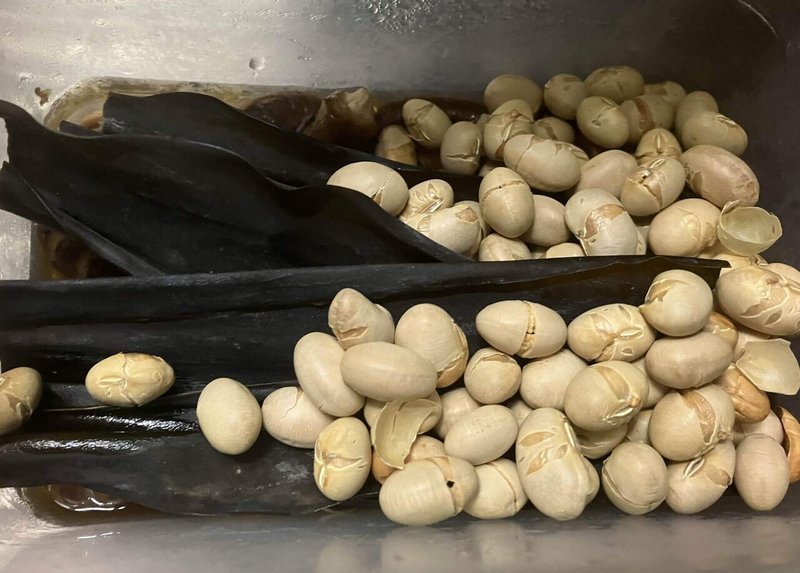

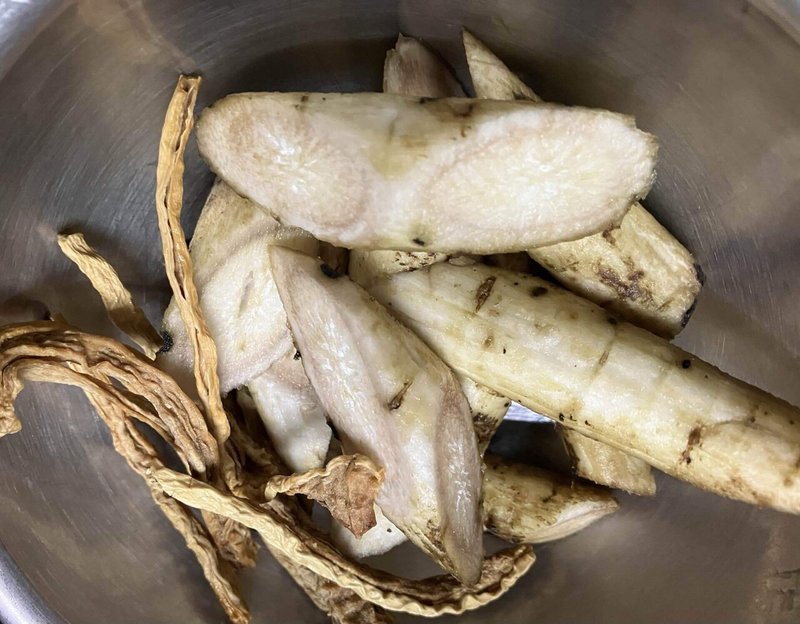
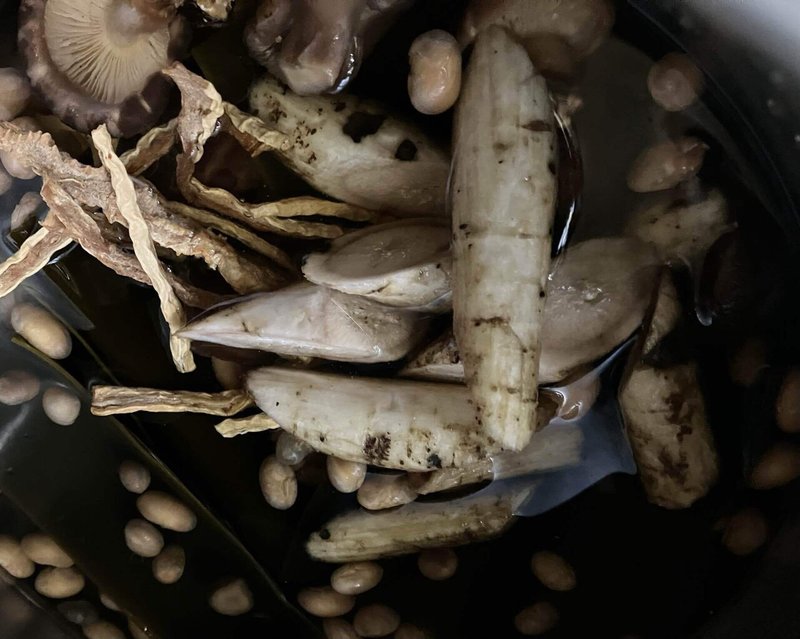
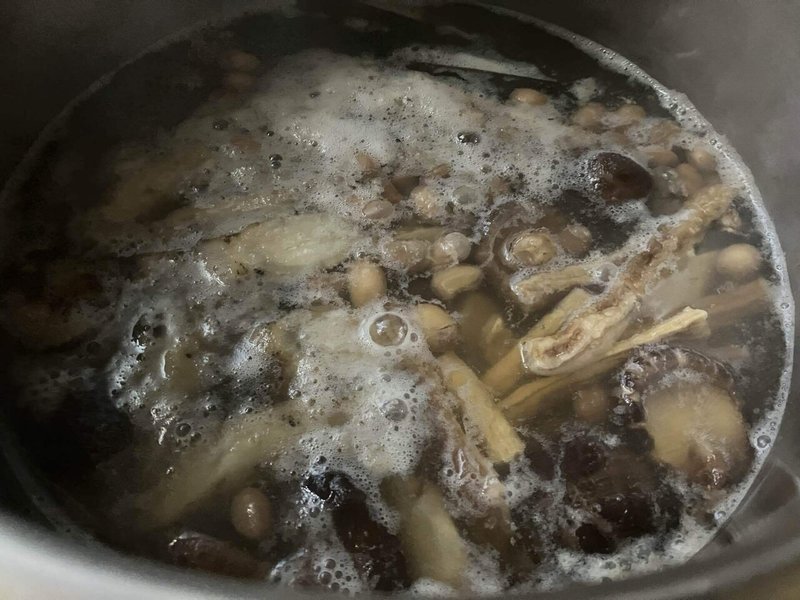
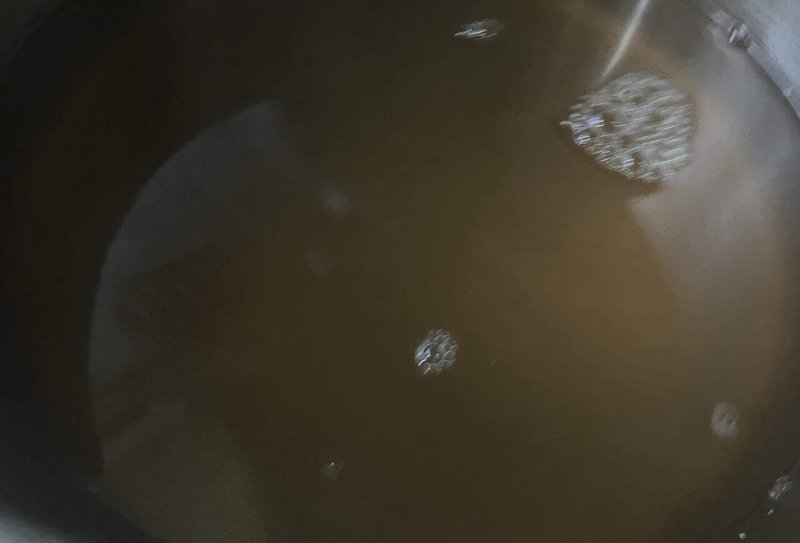

Tips and tricks:
コツと応用のヒント:
昆布と椎茸の出汁には煮干しのようなエッジがない。エッジを立てるため、香ばしく炒った大豆と牛蒡を加える。干し大根は自然の甘みと熟成感を与えてくれる。
人参、セロリ、パセリの茎、玉ねぎの皮などを加えてもより深みが出て興味深いがが、和風というよりは欧風のコンソメに近づいていくので、ここで入れていない。この辺りは用途によって勘案すると応用が広がる。
椎茸はおでんタネとしてそのまま使うので、一旦取り出した後、石突を落として取っておく。昆布と牛蒡もそのままおでんのタネとして使う。炒り大豆と乾燥大根は、刻んで薄揚げなどに詰めると良いおでんのタネになる。すり潰した豆腐に混ぜてがんもどきにしても良い。
好みで味醂を入れて少し甘味をつけても良い。
この出汁は、うどんやそばのスープ、天ぷらに添えるなど、他の用途にも使える。
The kelp and shiitake mushroom broth does not have the edge of dried sardines. To give it an edge, add roasted soybeans and burdock. Dried daikon radish gives it a natural sweetness and a sense of maturity.
Adding carrots, celery, parsley stems, onion skins, etc. would add depth and make it more interesting, but they are not included here as they make it more of a European-style consommé than a Japanese-style consommé. These ingredients can be used in a wide range of applications depending on the purpose.
The shiitake mushrooms are used as they are for the oden filling, so remove the stems and set aside. The kelp and burdock are also used as they are for the oden filling. Roasted soybeans and dried daikon radish make a good oden filling if you chop them up and stuff them into thin fried tofu. You can also mix them with mashed tofu to make ganmodoki.
You can add mirin to taste for a little sweetness.
This broth can also be used for other purposes, such as udon or soba soup, or for dipping tempura in it.
Guide to where to get ingredients and equipment 材料と機材の入手先ガイド
この記事が気に入ったらサポートをしてみませんか?
